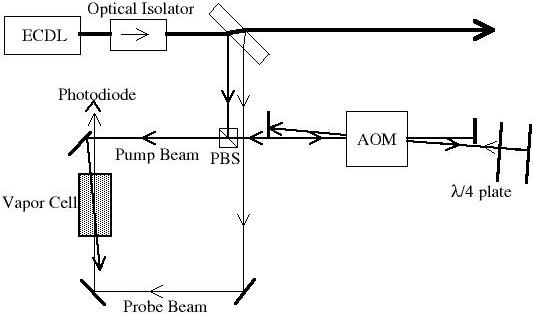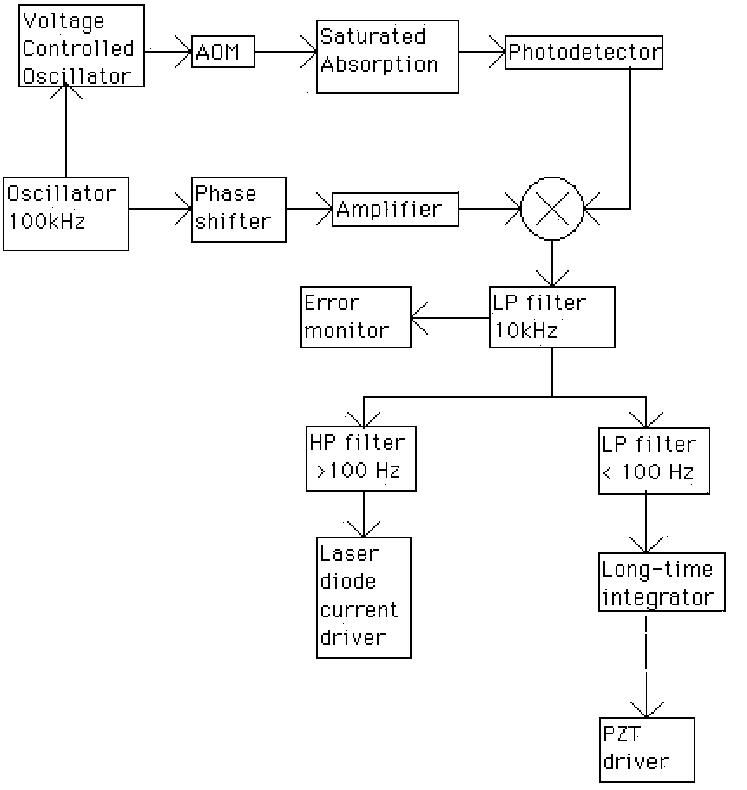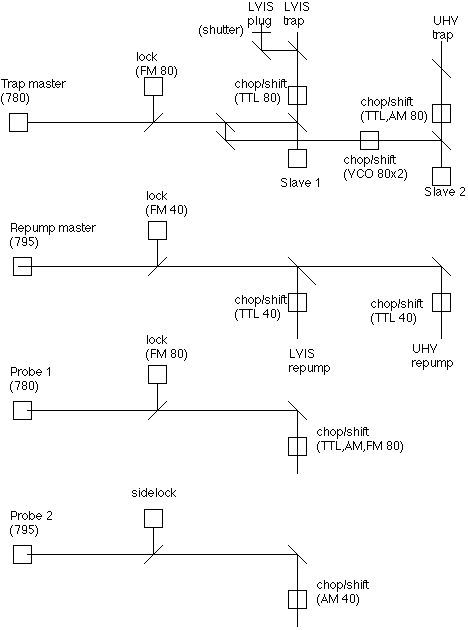Diode Laser System
For Laser Cooling and Spectroscopy
Steve Gensemer, 10.8.97 University of Connecticut Physics Dept.
Goals of the diode laser mount and locking circuitry:
-
provide linewidth/jitter narrowing to ~200kHz
-
isolate laser frequency from room temperature, pressure, vibration and
weather effects
-
provide locking to spectral features with <1MHz reproducibility
-
robust locking that keeps lasers locked for duration of experiment (>10
hours)
-
provide rapid, flexible frequency tuning, fast switching, and fast amplitude
modulation of all beams
-
provide high power (>50mW) in any beam desired
-
be easily extendable (higher power, more slave lasers, MOPA, etc.)
Diode Laser Cavity/Mount
following Hänsch, Optics Commun. 117 (1995) 541-549
commercial version available from TUI
Goals:
-
provide linewidth narrowing
-
minimal frequency drift (creeping, thermal expansion)
-
easily tunable
-
airtight (isolated from pressure/humidity fluctuations)
Solution:
-
Littrow configuration (high output power, simplicity)
-
Ultra-fine pitch screws for critical adjustments
-
Holographic grating
-
Entire cavity is thermally stabilized with Peltier cooler (and made of
Invar?)
-
Cavity is enclosed in airtight box with vacuum feedthroughs and AR-coated
output window
-
Box is attatched to thermal heatsink for thermal stabilization
Goals:
-
provide repeatable frequency reference for long-term locking
-
provide fast frequency discriminator to accuracy of a few 100 kHz.
Solution: Saturated Absorption spectroscopy
-
Probe beam is modulated independent of pump beam by double pass through
AOM
-
Saturated absorption peaks at AOM frequency away from atomic resonance

Lock Circuit Electronics
following design obtained from Kurt Gibble of Yale University.
Goals:
-
Reduce natural (acoustic) jitter of diode laser from ~2MHz to a few 100kHz
-
Long-time integration to keep laser locked within a few 100kHz of
line center for many hours
-
Low noise
-
Adjustable modulation frequency and gain
-
Slow (~30Hz) sweep capability (for observing saturated absorption lines
before locking)
Solution:
-
Use PZT to compensate for long-term drifts
-
Use injection current to compensate for short-term drifts/acoustic jitter

AOM drivers
Goals:
-
Provide voltage-tunable carrier for 80-100MHz AOMs
-
Optional TTL switching of AOMs
-
Optional voltage-controlled amplitude modulation
Solution:
-
Use VCO to provide tunable carrier with both potentiometer offset and voltage
modulation (POS-100, MiniCircuits)
-
TTL switching provided by TTL switch at output of VCO (PSW-1211, MiniCircuits)
-
Amplitude modulation provided by bi-phase attenuator at output of VCO (PAS-3,
MiniCircuits)
-
1 Watt amplifier to boost carrier for driving AOM (CA2832C, Motorola)
-
Each component in separate (Bud) die-cast aluminum box with BNC connectors
(provide flexibility, minimize radiation)
-
AOMs can be used for tuning, attenuating, switching any laser - they can
also be used for controlling slave lasers independently from master lasers
Use of AOMs and Injection Locking
Below is an example of the use of AOMs for providing flexible frequency
and amplitude control of many different lasers.
In injection locking, the full jitter reduction and fequency stability
of the master laser is transferred to all the slave lasers.
